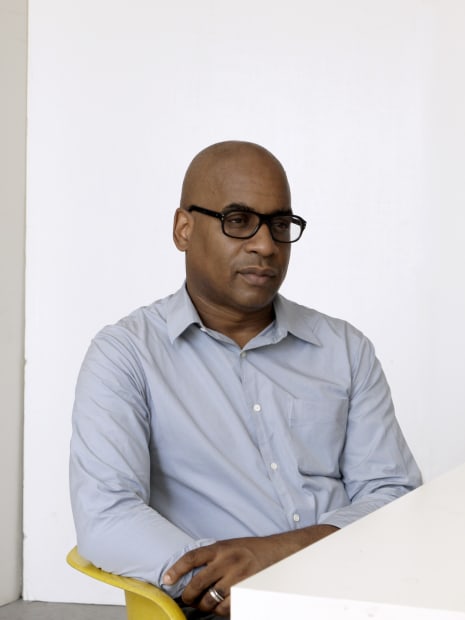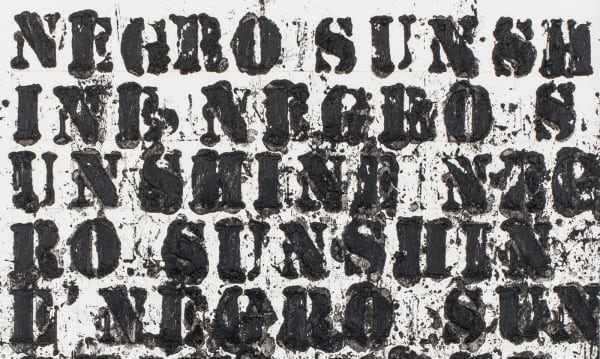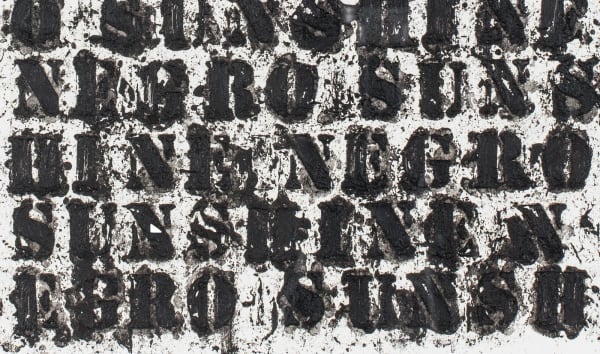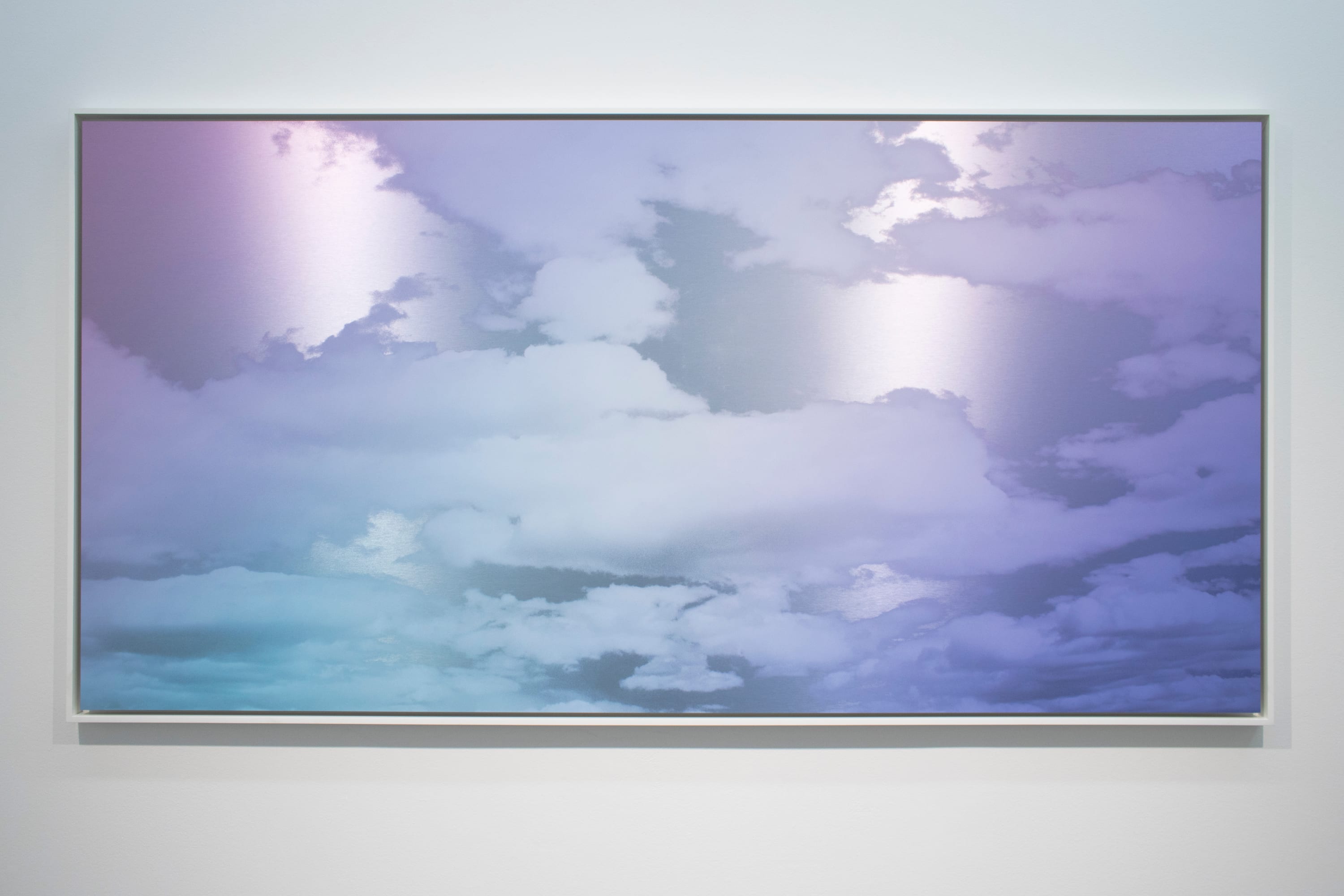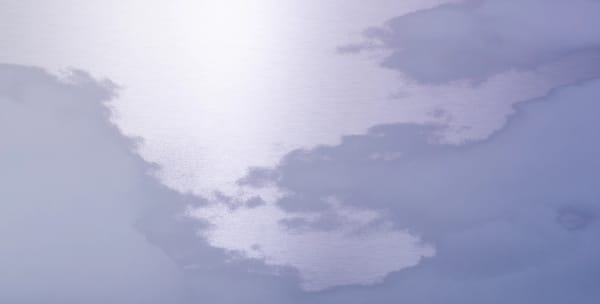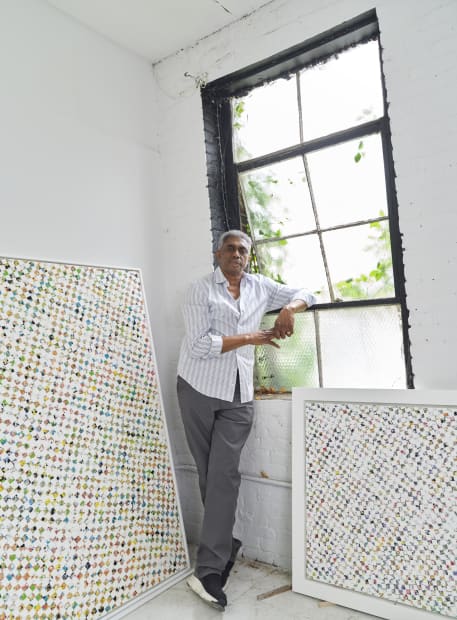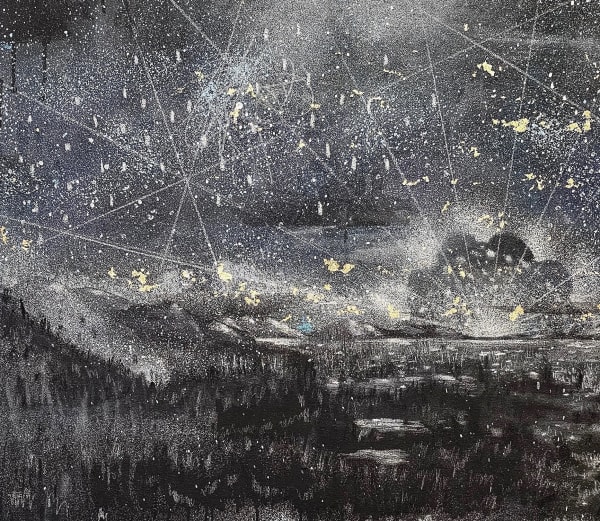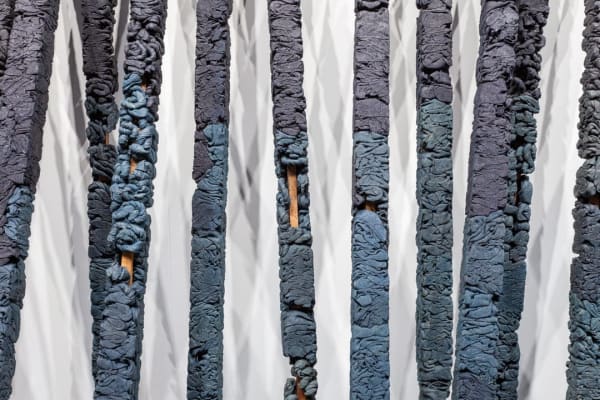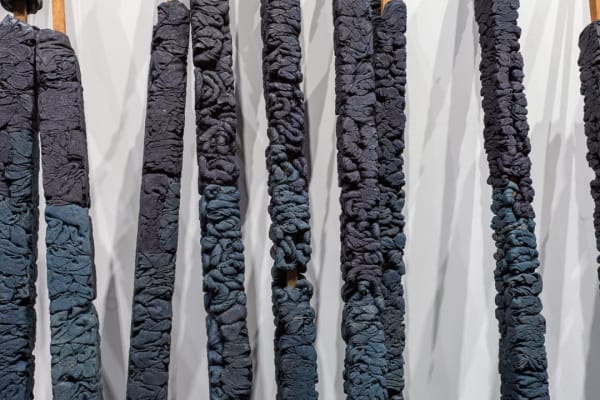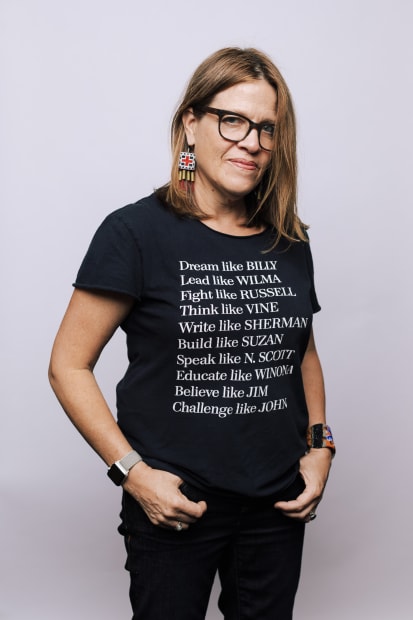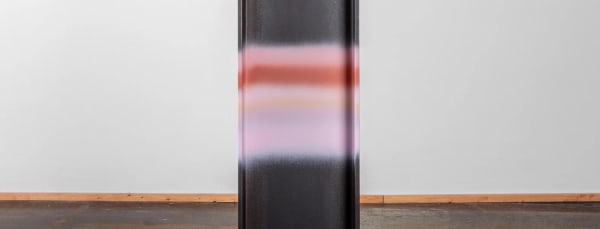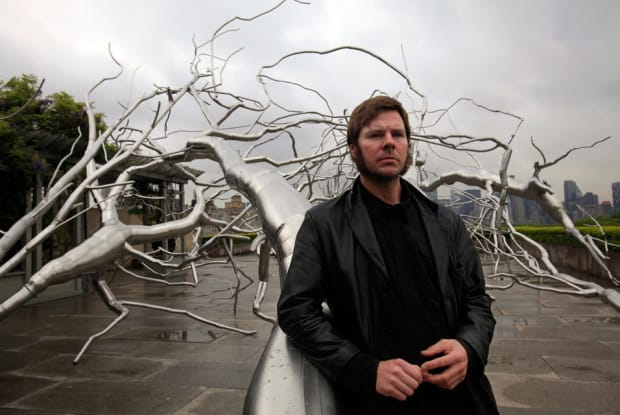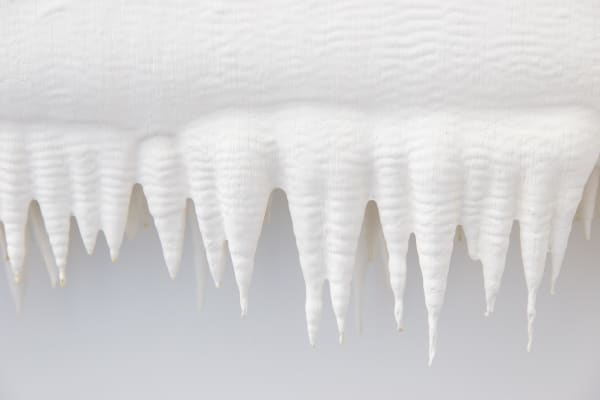-
Light Space
-
Kavi Gupta presents Lightspace, a group exhibition examining aesthetic spaces, physical and metaphysical, within contemporary art where concepts of lightness are central to the work. In this exhibition, a lightspace can be a zone of literal brightness, a mental space free from heavy burdens, or an ethereal space welcoming of contemplation; it could describe a symbolic depiction of shine, a poetic representation of illumination, or a material transformed into a source of reflective light.Each work in the exhibition addresses lightspace from a distinctive position—some in a conceptual sense, such as Glenn Ligon’s Study for Negro Sunshine II; some from a meditative viewpoint, like Miya Ando’s Unkai (Sea of Clouds) series, or in an abstract context, like James Little’s White Paintings; some from a metaphysical point of view, or from a celestial perspective, like Michi Meko’s So simple then: Cause I find myself in the place where I'm last seen, or from a minimalist viewpoint, like Manish Nai’s untitled circular, hanging jute works.Though each is unique, together the works argue for lightspace as a multifaceted, if somewhat fugitive, essence, difficult to condense, yet evident within many threads of contemporary art.
-
Glenn Ligon
-

-

Glenn Ligon
Study for Negro Sunshine II, #31, 2011Oil Stick, and gesso on paper
12 x 9 paper
14.5 x 11.5 x 1.5 frame
Framed in white wood frame with glazing. -
In 2011 the Whitney Museum of American Art held a mid-career retrospective of Ligon's work, Glenn Ligon: America, organized by Scott Rothkopf, that traveled nationally. Important shows include Glenn Ligon: Encounters and Collisions (2015), a curatorial project organized with Nottingham Contemporary and Tate Liverpool; and Blue Black (2017), an exhibition Ligon curated at the Pulitzer Arts Foundation in St. Louis, inspired by the site-specific Ellsworth Kelly wall. Ligon has also been the subject of solo museum exhibitions at the Camden Arts Centre in London, the Power Plant in Toronto, the Walker Art Center in Minneapolis, and the Studio Museum in Harlem, among others. His work has been included in major international exhibitions, including the Venice Biennale (2015 and 1997), Berlin Biennale (2014), Istanbul Biennial (2011), Documenta XI (2002), and Gwangju Biennale (2000).
-
Miya Ando
-

-
Miya Ando is a multidisciplinary abstract artist whose works reference the ephemerality of nature and the transitory nature of existence.Employing images and forms reference such fleeting stuff as clouds, moonlight, tides, and the seasons. Her materials—such as steel, glass, and aluminum—convey a sense of durability and strength. Transformed by Ando, materials related to permanence become embodiments of impermanence.
Ando presents the titles of her works in Japanese and English. During her time living in Japan, she researched literary and historical texts, compiling poetic Japanese descriptions of natural phenomena. Present in the Japanese descriptions are nuanced layers of thought often lacking in the English translation. These bi-lingual titles convey the sense of duality Ando experiences living between two cultures.
-

Miya Ando
UNKAI (SEA OF CLOUDS) BLUE LAVENDER PINK BOLINAS DECEMBER 5 2020 8:38 AM, 2020Ink on aluminum composite48 x 96 in
121.9 x 243.8 cm -
Ando’s work has been the subject of recent solo exhibitions at The Asia Society Museum, Houston; The Noguchi Museum, New York; Savannah College Of Art and Design Museum, Savannah; The Nassau County Museum, Roslyn Harbor; and The American University Museum, Washington DC. Her work has also been included in recent group exhibitions at The Crystal Bridges Museum of American Art, Bentonville; The Los Angeles County Museum of Art; The Haus Der Kunst, Munich; The Bronx Museum; and The Queens Museum of Art, NY. Ando’s work is included in the public collections of LACMA; The Nassau County Museum; The Corning Museum of Glass; The Detroit Institute of Arts; The Luft Museum; Scottsdale Museum of Contemporary Art; The Santa Barbara Museum of Art; The Museum of Art and History; among other public institutions as well as in numerous private collections. Ando has been the recipient of several grants and awards including the Pollock-Krasner Foundation Grant Award, and has produced numerous public commissions, most notably a thirty-foot-tall sculpture built from World Trade Center steel installed in Olympic Park in London to mark the ten-year anniversary of 9/11, for which she was nominated for a DARC Award in Best Light Art Installation. Ando was also commissioned to create artwork for the historic Philip Johnson Glass House, New Canaan, CT. The artist holds a bachelor’s degree in East Asian Studies from the University of California, Berkeley, studied East Asian Studies at Yale University and Stanford University, and apprenticed with a Master Metalsmith in Japan.
-
James Little
-

-
James Little is a master in the field of contemporary American abstract painting. In an age that frequently trades durability and patience for ephemerality and instant gratification, Little might be seen as an outlier. A careful, precise, disciplined perfectionist who emphasizes personal improvement over outside recognition, Little offers an alternative definition of influencer to a culture obsessed with quick returns and fame for fame's sake.Little’s distinctive visual position is based on a rigorous, life long academic study of color theory, pictorial design, and painting techniques. Rooted in simplicity, his work centers geometric shapes, patterns and emotive color relationships.The restraint of his pictures belies the startling complexity of their making—Little makes his own binders and grinds his own pigments, and paints a majority of his works using what is the most complex and difficult-to-master method ever devised: blending handmade pigments with hot beeswax, similar to the encaustic painting technique developed by ancient Egyptian and Greek artists. Properly cared for, his wax paintings will look as vibrant and luminous a thousand years from now as they do today.
-

James Little
Calculated Risk, 2022Oil on linen
64 x 74 in
162.6 x 188 cm -
Little holds a BFA from the Memphis Academy of Art and an MFA from Syracuse University. He is a 2009 recipient of the Joan Mitchel Foundation Award for Painting. In addition to being featured prominently in the 2022 Whitney Biennial at the Whitney Museum of American Art in New York, NY, his work has been exhibited extensively in solo and group exhibitions around the world, including at MoMA P.S.1, New York, NY; Crystal Bridges Museum of American Art, Bentonville, AR; Studio Museum in Harlem, New York, NY; St. Louis Art Museum, St. Louis, MO; and the Smithsonian Institute, Washington, DC. His work has been included in The Dirty South: Contemporary Art, Material Culture, and the Sonic Impulse at Virginia Museum of Fine Arts, Richmond, VA, curated by Valerie Cassel Oliver and traveling to Crystal Bridges Museum of American Art, Bentonville, AR, with forthcoming catalogue. Upcoming solo exhibitions include Homecoming: Bittersweet, at Dixon Gallery & Gardens: Art Museum, Memphis, TN, with an accompanying catalogue, and at Kavi Gupta, Chicago, IL, in 2022. His paintings are represented in the collections of numerous public and private collections, including the Virginia Museum of Fine Art, Richmond; Studio Museum in Harlem, New York; DeMenil Collection in Houston; Library of Congress, Washington, DC; Maatschappij Arti Et Amicitiae, Amsterdam, Holland; Saint Louis Art Museum, Saint Louis; Everson Museum of Art, Syracuse; New Jersey State Museum, Trenton; Tennessee State Museum, Nashville; Arkansas Arts Center, Little Rock; and Newark Museum, Newark.
-
Michi Meko
-

-
Michi Meko is a multidisciplinary artist whose rigorous studio practice is grounded in a material, metaphorical, and philosophical examination of what he calls “the African American experience of navigating public spaces, particularly in the American South, while remaining buoyant within them.”Incorporating romanticized found objects as well as the visual language of mapping, flags, and wayfinding into his work, Meko constructs transcendent aesthetic spaces into which the viewer’s psyche is free to wander.
-

Michi Meko
So simple then: Cause I find myself in the place where I'm last seen, 2023Acrylic, Gouache, Aerosol, graphite, gold leaf, hologram glitter, pom poms.
84 x 60 x 2 in
213.4 x 152.4 x 5.1 cm -
Meko is the recipient of the Joan Mitchell Foundation Grant and the Atlanta Artadia Award, and was a finalist for the 2019 Hudgens Prize. Recent exhibitions of Meko's work include Dark was the Night, Cold was the Ground, Kavi Gupta. Chicago, IL; The Dirty South, Virginia Museum of Fine Art, Richmond, VA; Realms of Refuge, Kavi Gupta, Chicago, IL; Michi Meko: Black and Blur, Clark Atlanta University Art Museum, Atlanta GA; Michi Meko: It Doesn’t Prepare You for Arrival, Museum of Contemporary Art of Georgia (MOCA GA), Atlanta, GA; Michi Meko: Before We Blast off: The Journey of Divine Forces, Atlanta Contemporary Art Center, Atlanta, GA and Abstraction Today, MOCA GA, Atlanta, GA. His work is held in the collections of the High Museum of Art, Atlanta, GA; King & Spalding, Atlanta, GA; Scion (Toyota Motor Corporation), Los Angeles, CA; MetroPark USA Inc., Atlanta, GA; and CW Network, Atlanta, GA, among others.
-
Manish Nai
-

-
Manish Nai is on the vanguard of contemporary abstraction. His studio practice is rooted strongly in materiality and process, especially as those elements relate to daily life in Mumbai, India, where Nai lives and works.Nai prioritizes materials that are both modest and quintessentially interconnected to his surroundings, such as jute, newspaper, indigo dye, second hand books and clothing, and reclaimed metal and paper. He fashions these materials into elegant geometric forms, while allowing them to retain their natural textures and colors.Many of Nai’s pieces are studies in tedious complexities, such as the long term effects of water, light, or gravity on organic materials. Nai is particularly interested in the ways materials evolve over the course of months and years. His works can be interpreted as visual expressions of the compression of time. When complete, they are presented as tightly organized units.
-

Manish Nai
Untitled, 2019Compressed natural indigo jute cloth and wood, 30 total pillars
Variable arrangements and poles
80 x 3 x 3 inches
203 x 7.5 x 7.5 cm -
Nai represented India in the 9th Shanghai Biennale, Mumbai City Pavilion, Shanghai, China, and is a Pollock-Krasner Foundation Award winner. His work has been exhibited by some of the most influential institutions in the world, including Het Noordbrabants Museum, Netherlands; Fondation Fernet-Branca, Saint-Louis, France; Devi Art Foundation, Kasturbhai Lalbhai Museum, Ahmedabad, India; Bhau Daji Lad Museum, Mumbai, India; NTU Center for Contemporary Art Singapore, Gillman Barracks, Singapore; Museum of Modern Art in Warsaw, Poland; The Sculpture Park at Madhavendra Palace, Nahargrah Fort, Jaipur, India; DR. Bhau Daji Lad Museum, Mumbai, India; Art Science Museum, Singapore; Birla Academy of Art & Culture, Kolkata, India; National Gallery of Modern Art, Mumbai, India; and Beppu Museum, Beppu, Japan. Nai earned a Diploma in Drawing and Painting from the L.S. Raheja School of Art in Mumbai, India.
-
Marie Watt
-

-
Marie Watt (b. 1967) is a Seneca artist whose bold, multi-sensory visual language celebrates and fosters community connections. Inviting people to explore and expand the boundaries of mutual relationships is an essential part of Watt’s aesthetic vocabulary. As a citizen of the Seneca Nation and a woman with German-Scot ancestry, her perspective has been shaped by values of connectivity and sharing.Drawing from history, biography, Iroquois protofeminism, and Indigenous teachings, Watt mobilizes her art practice as a form of visual and experiential storytelling. She frequently invites collaborators into her creative process, either as literal participants in the art making process or as contributors of materials or narratives that are then integrated into the work. Watt embraces and centers the stories embedded within those materials and narratives. Examples include her use of donated and vintage blankets, which frequently bear the scars of their histories in the form of flaws such as rips, repairs, or faded colors. Such markings connect Watt to the people who once used them, and to the moments of their lives that read like visual echoes stored within the objects.
-

Marie Watt
Skywalker Greets Sunrise, VIII, 2021Steel I-beam, cold rolled steel cap
96 x 24 x 24 in
243.8 x 61 x 61 cm
127 lbs -
Watt earned her MFA from Yale and attended the Institute of American Indian Arts with a focus on museum studies and studio arts. Her work has recently been featured in solo exhibitions at the Denver Art Museum in Colorado and Johnson Museum of Art at Cornell University, among many others, and group exhibitions at the Whitney Museum of American Art, Smithsonian American Art Museum, Seattle Art Museum, Crystal Bridges Museum of American Art, and the Peabody Essex Museum, Salem, MA, among many others. Watt’s work is included in the permanent collections of more than 80 museums and public institutions, including the Metropolitan Museum of Art, New York, NY; National Gallery of Art, Washington, DC; Smithsonian American Art Museum, Washington, DC; Whitney Museum of American Art, New York, NY; Crystal Bridges Museum of American Art, Bentonville, AR; National Gallery of Canada, Ottawa, Ontario, CA; Buffalo AKG Art Museum, Buffalo, NY; and Baltimore Museum of Art, Baltimore, MD.
-
Roxy Paine
-

-
Roxy Paine is a conceptual artist whose work expresses the collision of human industries and the natural world.Paine’s studio practice has mobilized an incredibly diverse range of subjects and materials, including custom-designed machines that create paintings; pristine wood and metal replicas of trees, fungus, weeds, and tools; full-size wooden dioramas of human-built environments such as a fast food restaurant, a security checkpoint, and an electronic control room. The work conveys various conflicts, such as those between industry and nature, control and chaos, and form and theory. Consistent across all of work is an echo of human involvement despite the noticeable lack of human figures.
-

-
Paine is a John Simon Guggenheim Memorial Foundation Fellow. His works are in the permanent collections of the Museum of Contemporary Art, Los Angeles, CA; San Francisco Museum of Modern Art (SFMoMA), San Francisco, CA; Museum of Modern Art (MoMA), New York, NY; the Whitney Museum of American Art, New York, NY; National Gallery of Art, Washington, DC; Denver Art Museum, Denver, CO; Crystal Bridges Museum of American Art, Bentonville, AR; Nelson-Atkins Museum of Art, Kansas City, MO; Hirshhorn Museum and Sculpture Garden, Washington, DC; Modern Art Museum of Fort Worth, TX; St. Louis Art Museum, St. Louis, MO; Fundación NMAC, Cadiz, Spain; National Gallery of Canada, Ottawa, Ontario, Canada; The Israel Museum, Jerusalem, Israel; De Pont Museum of Contemporary Art, Tilburg, Netherlands; among many others.
-
Richard Hunt
-

-
Richard Hunt is one of the most accomplished sculptors in the history of the United States. His work has been exhibited 12 times at the Museum of Modern Art in New York, including a solo retrospective in 1971 when Hunt was only 35 years old. Titled The Sculpture of Richard Hunt, this was only the third solo exhibition for a black artist in the history of MoMA. The director of that show referred to it as a “mid-career” exhibition, however Hunt is still active in his studio today, more than 50 years later.In the realm of large-scale works, Hunt’s more than 130 monumental public sculptures grace everything from the grassy sweeps of idyllic public parks to the imposing facades of steel and glass skyscrapers. He has been commissioned by corporations, hospitals, museums, municipalities, universities and athletic organizations. One of his proudest accomplishments is the welded bronze sculpture Swing Low (2016), which hangs in the lobby of the Smithsonian National Museum of African American History and Culture in Washington, DC.
-
-
Hunt has been celebrated in more than 100 solo exhibitions, including retrospectives at MOMA; The Art Institute of Chicago; The Studio Museum in Harlem, NY; Georgia Museum of Art, Athens, GA; and the Milwaukee Art Center, Milwaukee, WI. More than a dozen major monographs have been published of Hunt’s work. His career has also been the subject of two documentary films, and critical reviews in scores of the most influential art publications of the past century. Other major recent exhibitions of Hunt's work include Solo Presentation, Frieze Masters 2019, London, England; The Sculpture of Richard Hunt; Richard Hunt: Framed and Extended, The Studio Museum in Harlem, NY, USA; Smithsonian National Museum of African American History and Culture in Washington, DC; Richard Hunt, Georgia Museum of Art, Athens, GA, USA; Cleveland Museum of Art, Ohio, USA; Art Institute of Chicago, USA; Indianapolis Museum of Art, IN, USA and the Museum of African American History Detroit, MI, USA.
Lightspace: Kavi Gupta | Washington Blvd | Fl. 2
Past viewing_room
